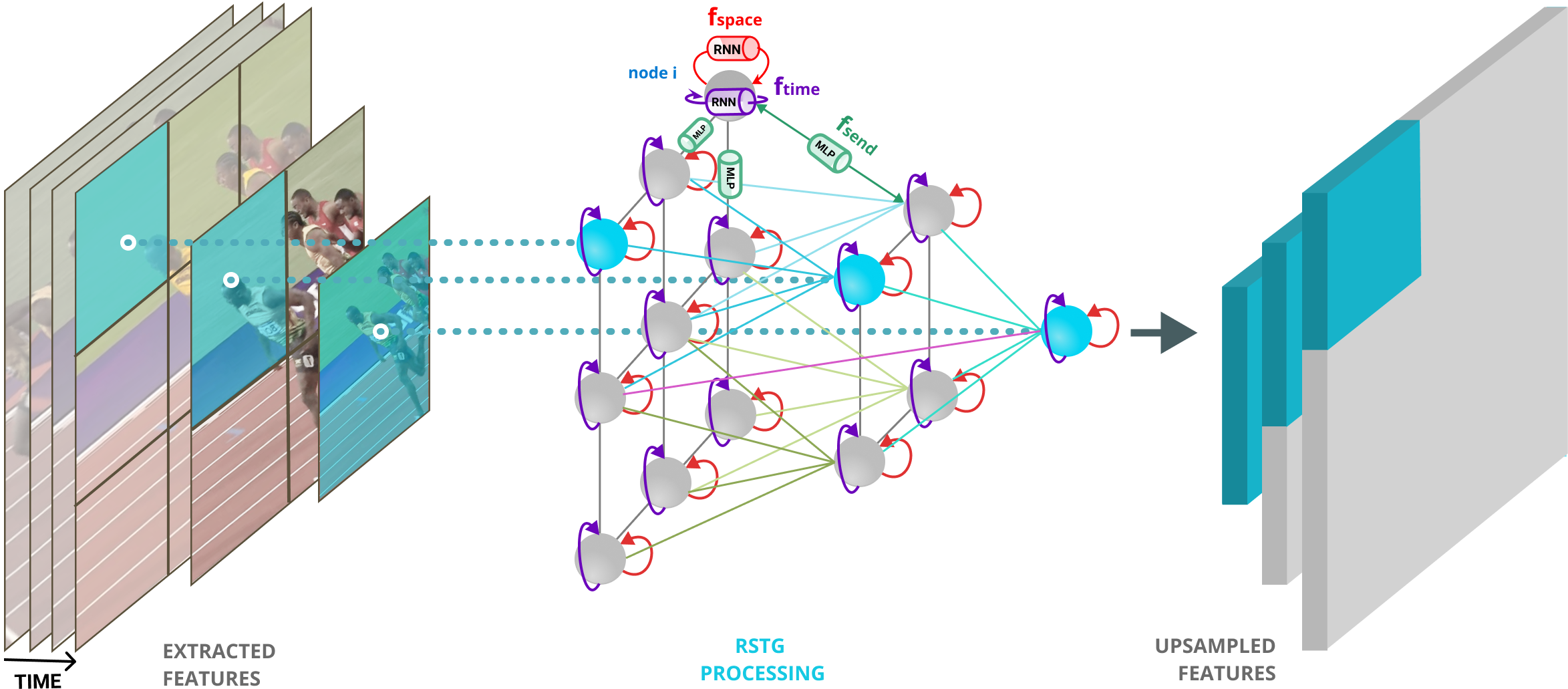This is the Tensorflow implementation of the RSTG model described in our paper Recurrent Space-time Graph Neural Networks
Please use the following BibTeX in case you use this repository in your work.
@incollection{rstg_2019,
title = {Recurrent Space-time Graph Neural Networks},
author = {Nicolicioiu, Andrei and Duta, Iulia and Leordeanu, Marius},
booktitle = {Advances in Neural Information Processing Systems 31},
year = {2019}
}
The repository contains the implementation of the RSTG model and our Tensorflow implementation of Non-Local, I3D, C2D models used as backbones.
models/graph_model/code for our RSTG modelmodels/backbone_models/code for SimpleConv, C2D, I3D, and Non-Local backbonescreate_datasets/code for extractivg the dataset in the format used by usconfigs/configuration files for our provided modelsscripts/scripts for starting the training / evaluation or for dataset creationtrain.pymain function for training and evaluating a model
Create a Conda enviroment with the following configuration:
- python 3.6.8
- tensorflow-gpu 1.13.1
- numpy 1.16.2
- CUDA 10
You can find here some checkpoint described in our paper, trained on Something-Something dataset with Kinetics pre-training.
Please put the checkpoints in ./checkpoints/
- Download Something-Something-v1 dataset and extract it in ./datasets/
- Run
mkdir datasets
./scripts/create_smt-smt_dataset_train.sh
./scripts/create_smt-smt_dataset_valid.shOptionally: create validation dataset containing multiple clips per video for dense evaluation.
./scripts/create_smt-smt_dataset_valid_multiclips.shRun
mkdir datasets
./scripts/create_syncMNIST.sh
./scripts/create_syncMNIST_test.shWe provide checkpoints for the models trained on Something-Something-v1, as described in our paper, initialized from I3D or C2D models pretrained on Kinetics.
We also give Tensorflow checkpoints for I3D and C2D models trained on Kinetics from Non-Local repository.
| Model | Config File | Checkpoint |
|---|---|---|
| c2d_kinetics | config_kinetics_c2d.yaml | ckpt |
| i3d_kinetics | config_kinetics_i3d.yaml | ckpt |
| Model | Config File | Checkpoint |
|---|---|---|
| c2d | config_smt_c2d.yaml | ckpt |
| c2d_rstg | config_smt_c2d_rstg_final.yaml | ckpt |
| i3d | config_smt_i3d.yaml | ckpt |
| i3d_rstg_final | config_smt_i3d_rstg_final.yaml | ckpt |
| i3d_rstg_res3_res4 | config_smt_i3d_rstg_res3_res4.yaml | ckpt |
Download the desired model in ./checkpoints/ and use the appropiate configuration file from ./config/ in order to evaluate it, by setting --config_file in ./scripts/run_smt-smt.sh.
You can fine-tune from the backbones pretrained on Kinetics or you can start from scratch by setting the --restore flag in your config file.
# 1. create a config file similar to the ones in ./configs/ for your desired model
# 2. make sure you have the flag --mode=train
# 3. give the path to the config file to the script ./scripts/run_smt-smt.sh (-config_file)
./scripts/run_smt-smt.sh new_model_name
# the model will be saved in ./checkpoints/We evaluate the models in two manners. In the first one, we evaluate a central 224x224 crop for each video. In the second one we extract N=11 256x256 crops uniformly sampled on the width of the frames for covering the entire spatial size of the video, and use 2 samplings along the time dimension, resulting in 2N = 22 clips. The final prediction is the average of the clips predictions.
Evaluate one clips.
# 1. create a config file similar to the ones in ./configs/ for your desired model
# 2. put the path to the evaluated model in the config file (--restore_dir) and --restore=True
# 3. make sure you have the flag --mode=eval
# 4. give the path to the config file to the script ./scripts/run_smt-smt.sh (--config_file)
./scripts/run_smt-smt.sh new_model_nameEvaluate multiple clips. Use a config file containing --num_eval_spatial_clips : 11, --num_eval_temporal_clips : 2 and --test_dataset pointing to the appropiate path.
# 1. create a config file similar to the ones in ./configs/config_smt_dense_i3d_rstg_final.yaml for your desired model
# 2. put the path to the evaluated model in the config file (--restore_dir) and --restore=True
# 3. make sure you have the flag --mode=eval
# 4. give the path to the config file to the script ./scripts/run_smt-smt.sh (--config_file)
./scripts/run_smt-smt.sh new_model_name